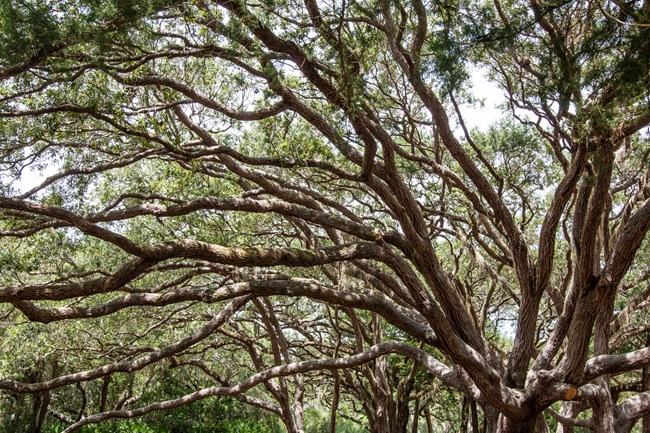
NPS While many species of oak trees are found throughout the world’s temperate zones, live oaks (Quercus virginiana) are native only from Virginia south to Florida and west to central Texas, especially thriving in the heat and humidity near the coast where they often form dense stands such as along the Fort Matanzas nature trail. Some of these trees, especially in the scrub area, are the closely related subspecies-- sand live oak (Quercus viginiana var. geminata) and dwarf live oak (Quercus virginina var. minima). Live oaks possibly get their name because, unlike most other oaks which drop their leaves in the winter and might look dead, live oaks keep their leaves year round and so look “live”. (Actually, live oaks do drop their leaves in late winter, but the new leaves have come out by then, so the tree is never bare.) Unlike many other oak trees, live oaks have narrow, smooth-edged leaves, although the leaves of young trees do show some teeth. The edges of these shiny, thick, dark green leaves often curl under. The thick, waxy coating and curling help the tree conserve moisture during the long, hot summers. Live oaks produce hanging male flowers called catkins which fill the air (and coat our automobiles) with yellow pollen in the spring. Small female flowers appear in clusters where the leaves join the twigs. Later, dark brown acorns are produced. The sweet meat within the acorn is coveted by birds, squirrels, and even deer. In earlier times, the Native Americans of the area ground live oak acorns into meal. Live oaks are fast growing, hardy trees that prefer acidic, sandy soil and lots of sun. They are fairly salt tolerant, but if you look at them from the side (try standing in the parking lot), you will notice that they appear to be bending away from the ocean. This is due to salt pruning in which salt in the air kills the tender buds on the side closest to the beach. Live oaks are known for their large size. The trees grow up to 60 feet tall, and the large canopy typically spreads nearly twice their height. The huge branches of mature trees droop and grow horizontally, sometimes even sweeping the ground. The champion live oak in Waycross, Georgia is 86 feet tall with a crown spread of 143 feet, and a trunk that is 10 feet in diameter. Live oaks are also known for their age. Some scientists think that the Angel Oak in Charleston, SC is more than 1,400 years old. Tree boring has dated the large oaks in the Fort Matanzas picnic area to over 150 years old. During the time of wooden sailing ships, live oak trees became very important because almost every curve found in a ship’s hull could be cut from the curing branches of live oaks. Also, the wood is very hard and strong. Dried live oak wood weighs about 60 lbs. per cubic foot, making it among the heaviest of any North American tree. The wood is also resistant to disease and decay. The USS Constitution was one of the famous ships built of live oak timbers, receiving the nickname Old Ironsides due to the strength of its oak construction. In the War of 1812 the USS Constitution engaged the British ship HMS Laurant. Old Ironsides shattered and crushed the Laurant's to assure a future supply of timber for the navy of the United States. The land that comprises this area is still protected there at the Naval Live Oak area of Gulf Islands National Seashore. |
Last updated: April 9, 2020
